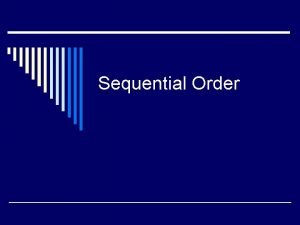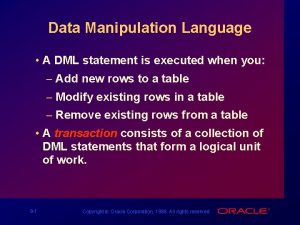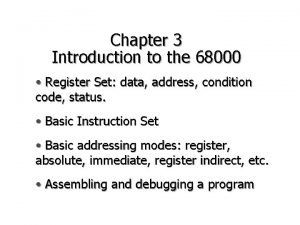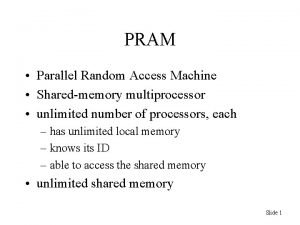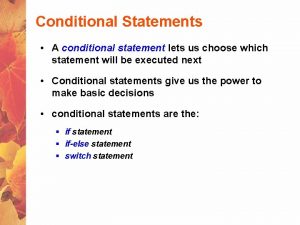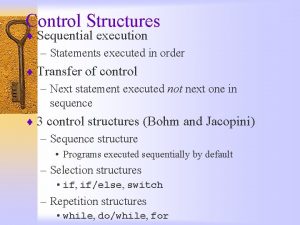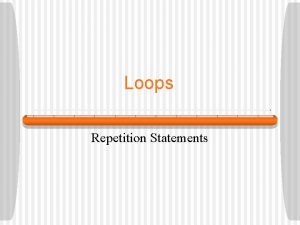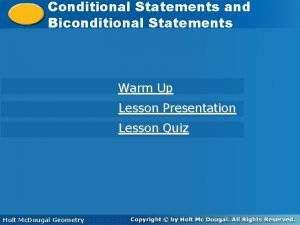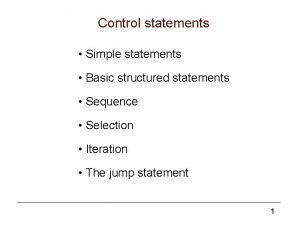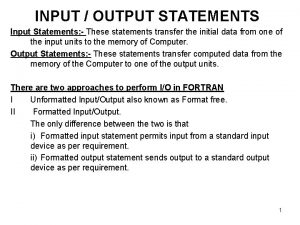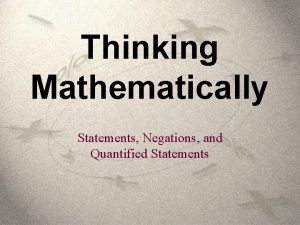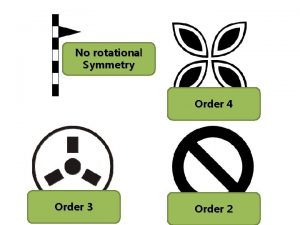Sequential Statements Executed according to the order in









![Loop Syntax [LOOP_LABEL : ] for IDENTIFIER in DISCRETE_RANGE loop -- sequential statements end Loop Syntax [LOOP_LABEL : ] for IDENTIFIER in DISCRETE_RANGE loop -- sequential statements end](https://slidetodoc.com/presentation_image_h2/89929f0cd6e78817feb1e0bd86c9ec3c/image-10.jpg)










- Slides: 20


Sequential Statements • Executed according to the order in which they appear • Permitted only within processes and subprograms • Used to describe algorithms 2 ﻣﺮﺗﻀﻲ ﺻﺎﺣﺐ ﺍﻟﺰﻣﺎﻧﻲ

IF Statement if CONDITION then -- sequential statements end if; if CONDITION then -- sequential statements else -- sequential statements end if; if CONDITION then -- sequential statements elsif CONDITION then -- sequential statements ··· else -- sequential statements end if; 3 • Condition is a boolean expression • Optional elsif sequence • • conditions may overlap • priority Optional else path • executed, if all conditions evaluate to false ﻣﺮﺗﻀﻲ ﺻﺎﺣﺐ ﺍﻟﺰﻣﺎﻧﻲ

IF Statement: Example entity IF_STATEMENT is port (A, B, C, X : in bit_vector (3 downto 0); Z : out bit_vector (3 downto 0); end IF_STATEMENT; architecture EXAMPLE 1 of IF_STATEMENT is begin process (A, B, C, X) begin Z <= A; if (X = "1111") then Z <= B; elsif (X > "1000") then Z <= C; end if; end process; end EXAMPLE 1; 4 architecture EXAMPLE 2 of IF_STATEMENT is begin process (A, B, C, X) begin if (X = "1111") then Z <= B; elsif (X > "1000") then Z <= C; else Z <= A; end if; end process; end EXAMPLE 2; ﻣﺮﺗﻀﻲ ﺻﺎﺣﺐ ﺍﻟﺰﻣﺎﻧﻲ

IF Statement: Example ( ﻣﻲ ﺷﻮﻧﺪ skip ﺍﻭﻝ ﺩﺍﺭﺍﻱ ﺑﻴﺸﺘﺮﻳﻦ ﺍﻭﻟﻮﻳﺖ ﺍﺳﺖ )ﺍگﺮ ﺷﺮﻁ ﺑﺮﻗﺮﺍﺭ ﺑﺎﺷﺪ ﺑﻘﻴﺔ ﺩﺳﺘﻮﺭﺍﺕ ﺗﺎ آﺨﺮ IF • ﺷﺮﻁ Z <= B ﻫﻤپﻮﺷﺎﻧﻲ ﺩﺍﺭﻧﺪ ﺍﻣﺎ ﺑﻪ ﺩﻟﻴﻞ ﺍﻭﻟﻮﻳﺖ ﺍﻭﻟﻲ elsif ﻭ if • ﺩﻭ ﺷﺮﻁ architecture EXAMPLE 1 of IF_STATEMENT is begin process (A, B, C, X) begin Z <= A; if (X = "1111") then Z <= B; elsif (X > "1000") then Z <= C; end if; end process; end EXAMPLE 1; 5 architecture EXAMPLE 2 of IF_STATEMENT is begin process (A, B, C, X) begin if (X = "1111") then Z <= B; elsif (X > "1000") then Z <= C; else Z <= A; end if; end process; end EXAMPLE 2; ﻣﺮﺗﻀﻲ ﺻﺎﺣﺐ ﺍﻟﺰﻣﺎﻧﻲ

CASE Statement case EXPRESSION is when VALUE_1 => -- sequential statements when VALUE_2 | VALUE_3 => -- sequential statements when VALUE_4 to VALUE_N => -- sequential statements when others => -- sequential statements end case ; • Choice options must not overlap • All choice options have to be covered • single values • selection of values ("|" means "or") • value range • "when others" covers all remaining choice options . ﻣﻘﺎﺩﻳﺮ ﺑﺎﺷﺪ type ﺑﺎﻳﺪ ﻣﻄﺎﺑﻖ case header ﻋﺒﺎﺭﺕ type • 6 ﻣﺮﺗﻀﻲ ﺻﺎﺣﺐ ﺍﻟﺰﻣﺎﻧﻲ

CASE Statement Example entity CASE_STATEMENT is port (A, B, C, X : in integer range 0 to 15; Z : out integer range 0 to 15; end CASE_STATEMENT; 7 architecture EXAMPLE of CASE_STATEMENT is begin process (A, B, C, X) begin case X is when 0 => Z <= A; when 7 | 9 => Z <= B; when 1 to 5 => Z <= C; when others => Z <= 0; end case; end process; end EXAMPLE; ﻣﺮﺗﻀﻲ ﺻﺎﺣﺐ ﺍﻟﺰﻣﺎﻧﻲ

Defining Ranges entity RANGE_1 is port (A, B, C, X : in integer range 0 to 15; Z : out integer range 0 to 15; end RANGE_1; architecture EXAMPLE of RANGE_1 is begin process (A, B, C, X) begin case X is when 0 => Z <= A; when 7 | 9 => Z <= B; when 1 to 5 => Z <= C; when others => Z <= 0; end case; end process; end EXAMPLE; 8 entity RANGE_2 is port (A, B, C, X : in bit_vector(3 downto 0); Z : out bit_vector(3 downto 0); end RANGE_2; architecture EXAMPLE of RANGE_2 is begin process (A, B, C, X) begin case X is when "0000" => Z <= A; when "0111" | "1001" => Z <= B; when "0001" to "0101" => -- wrong Z <= C; when others => Z <= 0; end case; end process; end EXAMPLE; ﻣﺮﺗﻀﻲ ﺻﺎﺣﺐ ﺍﻟﺰﻣﺎﻧﻲ

FOR Loops entity FOR_LOOP is port (A : in integer range 0 to 3; Z : out bit_vector (3 downto 0)); end FOR_LOOP; • Loop parameter is implicitly declared • cannot be declared externally • read only access architecture EXAMPLE of FOR_LOOP is • not visible outside the loop begin process (A) • The loop parameter adopts all values begin from the range definition Z <= "0000"; for I in 0 to 3 loop • integer ranges if (A = I) then Z(I) <= `1`; • enumerated types end if; end loop; end process; end EXAMPLE; type T_STATE is (START, EXECUTE, FINISH); … signal CURRENT_STATE, NEXT_STATE : T_STATE ; 9 ﻣﺮﺗﻀﻲ ﺻﺎﺣﺐ ﺍﻟﺰﻣﺎﻧﻲ
![Loop Syntax LOOPLABEL for IDENTIFIER in DISCRETERANGE loop sequential statements end Loop Syntax [LOOP_LABEL : ] for IDENTIFIER in DISCRETE_RANGE loop -- sequential statements end](https://slidetodoc.com/presentation_image_h2/89929f0cd6e78817feb1e0bd86c9ec3c/image-10.jpg)
Loop Syntax [LOOP_LABEL : ] for IDENTIFIER in DISCRETE_RANGE loop -- sequential statements end loop [LOOP_LABEL] ; • Optional label • Use especially for nested loops • Range attributes [LOOP_LABEL : ] while CONDITION loop -- sequential statements end loop [LOOP_LABEL] ; • ‘low • ‘high • ‘range Synthesis requirements: - Loops must have a fixed range - 'while' constructs usually cannot be synthesized 10 ﻣﺮﺗﻀﻲ ﺻﺎﺣﺐ ﺍﻟﺰﻣﺎﻧﻲ

Loop Examples entity CONV_INT is port (VECTOR: in bit_vector(7 downto 0); RESULT: out integer); end CONV_INT; architecture A of CONV_INT is begin process(VECTOR) variable TMP: integer; begin TMP : = 0; for I in 7 downto 0 loop if (VECTOR(I)='1') then TMP : = TMP + 2**I; end if; end loop; RESULT <= TMP; end process; end A; 11 architecture B of CONV_INT is begin process(VECTOR) variable TMP: integer; begin TMP : = 0; for I in VECTOR'range loop if (VECTOR(I)='1') then TMP : = TMP + 2**I; end if; end loop; RESULT <= TMP; end process; end B; architecture C of CONV_INT is begin process(VECTOR) variable TMP: integer; variable I : integer; begin TMP : = 0; I : = VECTOR'high; while (I >= VECTOR'low) loop if (VECTOR(I)='1') then TMP : = TMP + 2**I; end if; I : = I - 1; end loop; RESULT <= TMP; end process; end C; ﻣﺮﺗﻀﻲ ﺻﺎﺣﺐ ﺍﻟﺰﻣﺎﻧﻲ

WAIT Statement • 'wait' statements stop the process execution • The process is continued when the condition is fulfilled • Different types of wait statements: • wait for a specific time wait for SPECIFIC_TIME; • wait for a signal event wait on SIGNAL_LIST; • wait for a true condition (requires an event) wait until CONDITION; • indefinite (process is never reactivated) wait; 12 Wait statements must not be used in processes with sensitivity list ﻣﺮﺗﻀﻲ ﺻﺎﺣﺐ ﺍﻟﺰﻣﺎﻧﻲ

WAIT Statement: Examples • Flip Flop Model entity FF is port (D, CLK : in bit; Q : out bit); end FF; architecture BEH_1 of FF is architecture BEH_2 of FF is begin process begin wait on CLK; wait until CLK=`1`; if (CLK = '1') then Q <= D; end if; end process; end BEH_1; end BEH_2; 13 ﻣﺮﺗﻀﻲ ﺻﺎﺣﺐ ﺍﻟﺰﻣﺎﻧﻲ

WAIT Statement: Examples • Testbench: stimuli generation STIMULUS: process begin SEL <= `0`; BUS_B <= "0000"; BUS_A <= "1111"; wait for 10 ns; SEL <= `1`; wait for 10 ns; SEL <= `0`; wait for 10 ns; wait; end process STIMULUS; 14 ﻣﺮﺗﻀﻲ ﺻﺎﺣﺐ ﺍﻟﺰﻣﺎﻧﻲ

WAIT Statements and Behavioral Modelling Not synthesizable 15 ﻣﺮﺗﻀﻲ ﺻﺎﺣﺐ ﺍﻟﺰﻣﺎﻧﻲ

Variables architecture RTL of XYZ is signal A, B, C : integer range 0 to 7; signal Y, Z : integer range 0 to 15; begin process (A, B, C) variable M, N : integer range 0 to 7; begin M : = A; N : = B; Z <= M + N; M : = C; Y <= M + N; end process; end RTL; • Variables are available within processes and subprograms, only • named within process declarations • known only in this process • immediate assignment • keep the last value • Possible assignments • signal to variable • variable to signal • types have to match • VHDL 93: shared variables 16 ﻣﺮﺗﻀﻲ ﺻﺎﺣﺐ ﺍﻟﺰﻣﺎﻧﻲ

Variables vs. Signals signal A, B, C, Y, Z : integer; begin process (A, B, C) variable M, N : integer; begin M : = A; N : = B; Z <= M + N; M : = C; Y <= M + N; end process; signal A, B, C, Y, Z : integer; signal M, N : integer; begin process (A, B, C, M, N) begin M <= A; N <= B; Z <= M + N; M <= C; Y <= M + N; end process; • Signal values are assigned when process is suspended • M <= A; is overwritten by M <= C; • The adder inputs are connected to C In 2 nd process: M, N must be added to sensitivity list 17 ﻣﺮﺗﻀﻲ ﺻﺎﺣﺐ ﺍﻟﺰﻣﺎﻧﻲ

Use of Variables • Intermediate results of algorithm implementations • signal to variable assignment • execution of algorithm • variable to signal assignment • No access to variable values outside their process • Variables store their values until the next process iteration • synthesizers may generate latch or FF for it) 19 ﻣﺮﺗﻀﻲ ﺻﺎﺣﺐ ﺍﻟﺰﻣﺎﻧﻲ

Variables: Example • Parity calculation entity PARITY is port (DATA: in bit_vector (3 downto 0); ODD : out bit); end PARITY; • Synthesis result: architecture RTL of PARITY is begin process (DATA) variable TMP : bit; begin TMP : = ’ 0’; for I in DATA’low to DATA’high loop TMP : = TMP xor DATA(I); end loop; ODD <= TMP; end process; end 20 RTL; ﻣﺮﺗﻀﻲ ﺻﺎﺣﺐ ﺍﻟﺰﻣﺎﻧﻲ

Global Variables (VHDL'93) architecture BEHAVE of SHARED is shared variable S : integer; begin process (A, B) begin S : = A + B; end process; process (A, B) begin S : = A - B; end process; end BEHAVE; • shared variables: • Accessible by all processes of an architecture • Can introduce nondeterminism Not to be used in synthesizable code 21 ﻣﺮﺗﻀﻲ ﺻﺎﺣﺐ ﺍﻟﺰﻣﺎﻧﻲ
 1st order 2nd order 3rd order neurons
1st order 2nd order 3rd order neurons A house of sequential order
A house of sequential order Data manipulation language dml
Data manipulation language dml Who is it
Who is it Motorola 68000 instruction set
Motorola 68000 instruction set In random access machine, instructions are executed
In random access machine, instructions are executed Statement lets us choose the statement to be executed next.
Statement lets us choose the statement to be executed next. Henry viii wives executed
Henry viii wives executed The instruction being executed, must be in
The instruction being executed, must be in Put the pictures in order
Put the pictures in order Hát kết hợp bộ gõ cơ thể
Hát kết hợp bộ gõ cơ thể đặc điểm cơ thể của người tối cổ
đặc điểm cơ thể của người tối cổ Cái miệng xinh xinh thế chỉ nói điều hay thôi
Cái miệng xinh xinh thế chỉ nói điều hay thôi Cách giải mật thư tọa độ
Cách giải mật thư tọa độ Tư thế worm breton
Tư thế worm breton ưu thế lai là gì
ưu thế lai là gì Tư thế ngồi viết
Tư thế ngồi viết Gấu đi như thế nào
Gấu đi như thế nào Thẻ vin
Thẻ vin Thơ thất ngôn tứ tuyệt đường luật
Thơ thất ngôn tứ tuyệt đường luật Các châu lục và đại dương trên thế giới
Các châu lục và đại dương trên thế giới

